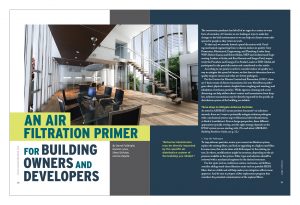An Air Filtration Primer for Building Owners and Developers
The coronavirus pandemic has left all of us eager for a return to some form of normalcy. At Gensler, we are looking at ways to make key changes to the built environment so we can help our clients create safer spaces for people as they return to work.
To that end, we recently hosted a panel discussion with 3 leading mechanical engineering firms to discuss indoor air quality. Gary Pomerantz, Mechanical, Engineering, and Plumbing Leader from WSP; Robert Ioanna and Robert Bolin, MEP and Architectural Engineering Leaders at Syska; and Kurt Karnatz and Saagar Patel, respectively the President and Energy+Eco Studio Leader at ESD Global, all participated in the panel discussion and contributed to this article.
According to our panel, in order to consider indoor air quality as a way to mitigate the spread of viruses, we first have to determine how air quality impacts viruses and other air-driven pathogens.
Per the Centers for Disease Control and Prevention (CDC)1, there are 3 basic means of disease transmission for non-bloodborne pathogens: direct physical contact, droplets from coughing and sneezing, and inhalation of airborne particles. While rigorous cleaning and social distancing can help address direct contact and transmission from droplets, airborne transmission may be directly impacted by the specific air distribution system of the building you inhabit.
Three Ways to Mitigate Airborne Particles
As noted in ASHRAE’s recent position document2 on infectious aerosols, there are 3 ways to potentially mitigate airborne pathogens with a mechanical system: trap it (filtration), kill it (disinfection), or flush it (ventilation). From a design perspective, these different approaches typically overlap, and the right strategy depends on the HVAC system you are starting with. (To read about ASHRAE’s
Building Readiness Guide, see p. 32.)
1. Trap the Pathogen
To trap airborne particles, review your current air filtration system, replace the existing filters, and look at upgrading to a higher rated filter. In some cases, this can be done with little impact to the existing system. In others, modifications might be necessary, depending on the air pressure available in the system. Filter types and selection should be reviewed with a mechanical engineer for the desired outcomes.
For hot spots such as conference centers, restrooms, and lobbies, consider adding stand-alone filtration units such as portable HEPA filters that are visible and will help make your mitigation efforts more apparent. And be sure to prepare a filter replacement program that considers the potential contamination of the replaced filters.
2. Kill the Pathogen
Another approach beyond filtration is to disinfect the air that is being conditioned. One of the most common disinfectant systems for HVAC uses ultraviolet-C (UVC) light to kill viruses in ductwork. Some mechanical systems may already have this feature, so simply replacing the UVC lamps can increase the potency of the system.
Beyond UV disinfectants, developers could consider bipolar ionization and photocatalytic oxidation. These systems charge the existing air to kill pathogens, and they do not require more outside air. Reliable testing for these systems is still in early stages, but the advanced technology shows potential.
3. Flush the Pathogen
Increasing the amount of fresh or outdoor air, and increasing the air change rate, are the most common and proven approaches to reducing unwanted airborne particles. Shifting your system into full air economizer mode, increasing your outdoor air damper positions, and adding air changes by night-flushing the system or running it continuously can all be effective approaches. Such frequent air exchanges will impact energy use and operating costs, but they are a necessary first step in helping to instill confidence for concerned tenants.
Design Considerations for New Buildings
Most projects will be able to incorporate some of these ideas into existing mechanical systems, but for new construction, there are additional considerations.
In new projects, developers should consider mechanical systems that have the ability to provide increased levels of outside air into the building. They could also consider ultraviolet germicidal irradiation (UVGI) light systems in the cooling coil section of air handlers, similar to those used at hospitals or labs, adjusting airflow rates to increase effectiveness.
Also, there are building design issues to think about. Air handling equipment that can scale to increase filtration during crisis events requires more space and greater flexibility. It may also be preferable to design mechanical systems that can isolate a single floor or alter the air pressure on a floor to respond to a potential contamination.
Relative humidity is another important consideration of any system. Studies have shown3 that pathogens have a difficult time surviving at higher relative humidity levels. However, indoor relative levels above 60% humidity can have negative effects in certain environments, such as facilitating the growth of mildew. So, providing for a tighter range of humidity (40–60%) can mitigate pathogens without causing other adverse effects.
Finally, all of the strategies discussed in this article depend on the ability to measure air quality. Building owners should look to standardized measuring systems that can provide independent verification and add to user confidence. Providing transparency with these measurements through lobby displays or other technology is an import aspect of this strategy.
When done right, air filtration systems can be an important element in the mitigation of the effects of pathogens—a key step toward improving indoor air quality and creating a safer, smarter, and more welcoming workplace.
REFERENCES
1. www.cdc.gov/infectioncontrol/spread/index.html
2. www.ashrae.org/file%20library/about/position%20documents/pd_infectiousaerosols_2020.pdf
3. www.ncbi.nlm.nih.gov/pmc/articles/PMC7165615/

